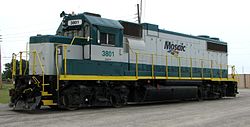The examples and perspective in this article may not represent a worldwide view of the subject.(July 2023) |
| Part of a series on |
| Rail transport |
|---|
 |
| Infrastructure |
| Rolling stock |
| Urban rail transit |
| Other topics |
| |
Rail transport terms are a form of technical terminology applied to railways. Although many terms are uniform across different nations and companies, they are by no means universal, with differences often originating from parallel development of rail transport systems in different parts of the world, and in the national origins of the engineers and managers who built the inaugural rail infrastructure. An example is the term railroad, used (but not exclusively) in North America, and railway, generally used in English-speaking countries outside North America and by the International Union of Railways. In English-speaking countries outside the United Kingdom, a mixture of US and UK terms may exist. [1]
Contents
- 0–9
- A
- B
- C
- D
- E
- F
- G
- H
- I
- J
- K
- L
- M
- N
- O
- P
- R
- S
- T
- U
- V
- W
- Y
- Z
- See also
- Notes
- References
- Further reading
- External links
Various terms, both global and specific to individual countries, are listed here. The abbreviation "UIC" refers to terminology adopted by the International Union of Railways in its official publications and thesaurus. [2]



















































